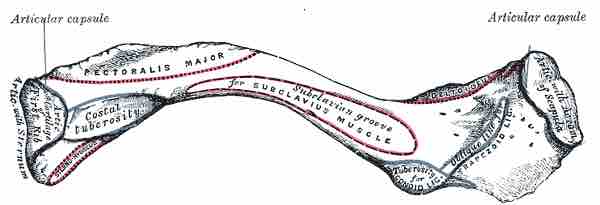The clavicle, or collarbone, is a slender s-shaped bone that extends between the sternum and the scapula and is located directly above the first rib. It functions to attach the upper arm to the trunk and provides support to allow free movement around the shoulder.

Left Clavicle
The left clavicle, viewed from above. Muscle attachment sites (pectoralis major, subclavius muscle, deltoid, and sterno-hyoid) are highlighted.
Medially the clavicle is quadrangular in shape and articulates with the manubrium of the sternum forming the sternoclavicular joint. Laterally, the clavicle is flattened and attaches to the acromion process of the scapula forming the acromioclavicular joint.
The shaft of the clavicle acts as the origin and attachment point for numerous muscles and ligaments. At the medial end of the shaft the pectoralis major originates from the anterior surface, the posterior surface gives origin to the sternohyoid muscle and the superior surface the sternocleidomastoid muscle.
The costoclavicular ligament attaches to the inferio≠r surface. Laterally the deltoid muscle originates from the anterior surface and the trapezius muscle attaches to the posterior surface at the trapezoid line. Adjacent to this is the conoid tubercle which is an attachment point for the conoid ligament.
The clavicle in males is typically thicker and longer than a female's clavicle to account for the larger muscle mass operating through it.